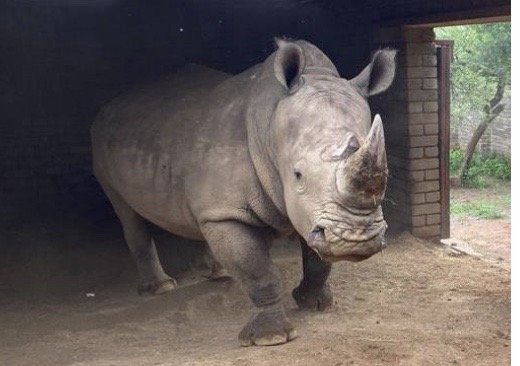Rhino Population Facts
At the beginning of the 20th century, 500,000 rhinos roamed Africa and Asia. By 1970, rhino numbers dropped to 70,000, and today, according to a recent report, there are now around 27,431 rhinos in Africa and Asia. Very few rhinos survive outside national parks and reserves due to persistent poaching and habitat loss. Three species of rhino—black, Javan, and Sumatran—are critically endangered.
3 Rhinos are killed everyday in Africa!
Only 2 Northern white rhinos, about 75 Javan rhinos and less than 80 Sumatran rhinos still remain, which makes them truly under threat of extinction.
The only two remaining northern white rhino are kept under 24-hour guard in Ol Pejeta Conservancy in Kenya. The two rhinos are related. And while scientists are still trying to create a scenario where a fertilized egg can be implanted in the younger rhino and take, so far they have been unsuccessful.
“We are in the last five minutes, but in those five minutes, there is hope.”
Why Rhinos Are Endangered
Poachers have become more sophisticated and more brutal in their efforts to obtain the rhino’s horn. Poachers now use military grade equipment and surveillance techniques, which can include helicopters and hiring mercenaries to do their dirty work. Once located, they land the chopper and brutally slaughter the rhino. Even though a rhino horn will grow back. They will still kill the rhino and any rhino calfs present if it’s a female, because the fewer rhino there are, the more valuable the horn becomes.
The black market of wildlife parts is all about supply and demand. So as long as there is a demand for it, there are those willing to fill that demand. Most of the demand for rhino horn comes from Asia. Culturally, many asians believe the rhino horn holds medicinal value. However, it has been proven to have no more medicinal properties than our fingernails do. Savvy marketers blend powdered viagra with the horn and sell it as a cure for male erectile dysfunction (ED). Sadly, the horn is also coveted in Asia as a status symbol of immense wealth. It is technically illegal to buy rhino horns, but this does not prevent the sale and purchase.
Conservationists are dehorning rhinos pre-emptively to detract poachers from targeting their rhinos. It’s an expensive procedure but it does not hurt the rhino. It’s like clipping our toe nails. The rhino is sedated and then a qualified veterinarian uses a powerful saw to cut off the horn.
Even with these measures, game reserves and private ranchers still have to provide 24hr/7days a week ranger protection to deter further deaths. It’s expensive - and many of the private reserves just can’t afford to keep this up.
The worst time of each month for rhino poaching is under the three days of a full moon. It’s so bright, poachers can find the rhinos with more ease.
Meet Valentino
Valentino is an 11-year old, white rhino located in a reserve in South Africa. Valentino has had an extremely traumatic and challenging life.
When he was a mere few months old, Valentino’s entire family was poached. Five rhinos murdered by savage poachers, in a single massacre. Valentino was left alone to live his early days out as an orphan, dealing with the trauma of witnessing his family being slaughtered around him.
Valentino was then moved to a rehabilitation facility where he was happily introduced to another young rhino. However, after the other rhino recently joined another herd, Valentino was left alone again. Valentino has struggled to settle into his new situation, endangering himself and others. He badly needs to be rehomed and find a new rhino to befriend.
Why Rhinos Are So Important
Rhinos are a vital part of the African ecosystem, playing a crucial role in maintaining the health and balance of their habitats. Here are just a few reasons why rhinos are so important:
Grazing: Rhinos are herbivores that graze on grasses, bushes, and trees. By doing so, they help to maintain the health of grasslands and other habitats by keeping vegetation in check. This in turn benefits other plant and animal species, ensuring the survival of a wide variety of species.
Seed Dispersal: Rhinos also play an important role in seed dispersal. As they move around their habitats, they eat fruits and berries, which pass through their digestive systems and are then deposited in their dung. This helps to spread seeds throughout their habitats, ensuring the survival of important plant species.
Soil Fertility: Rhino dung is also rich in nutrients and helps to fertilize the soil. This in turn benefits other plant species, helping them to grow and thrive.
Predators: Rhinos are also an important prey species for large predators such as lions, hyenas, and crocodiles. Without rhinos, these predators would struggle to find enough food, which could have a devastating impact on the entire ecosystem.
Did You Know … Black and White Rhinos are actually grey? And Rhino horns are made of the same stuff as our fingernails? Learn more facts about these amazing animals!
What We’re Doing To Stop Rhino Poaching
One project we continue to fund is the de-horning of rhinos in Africa. While nobody wants to see a dehorned rhino, the alternative is that they become a target for a poacher’s bullet or machete. We can all agree that a live rhino beats a poached rhino every time.
A rhino horn is worth more than gold and diamonds by weight. Horns command $40,000/kg for Asian rhino and $20,000/kg for African rhino. That’s why poaching for their horns and habitat loss threaten the future of these distinctive giants. We need your help to stop the decimation.
How Can You Help?
Use your social media accounts to share their story bring attention to their plight.
Report wildlife crime and support sustainable products.
Hold a local fundraiser in your community to raise funds to help our work.






